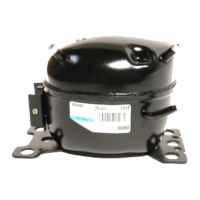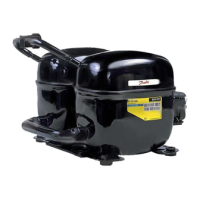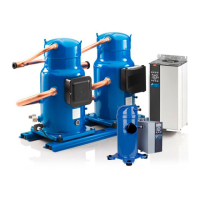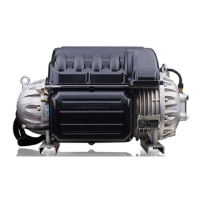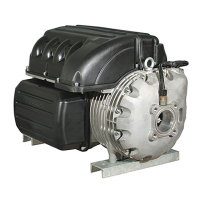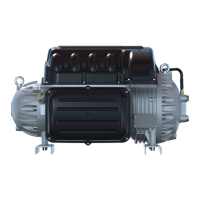Instructions
6 | AN245986497033en-000801 - 8510197P05J
© Danfoss | DCS (CC) | 2020.10
5 – Handling and storage
• Handle the compressor with care. Use the
dedicated handles in the packaging. Use the
compressor lifting lug and use appropriate
and safe lifting equipment.
• Store and transport the compressor in an
upright position.
• Store the compressor between Ts min and Ts
max values for LP side indicated on compres-
sor nameplate.
• Don’t expose the compressor and the packa-
ging to rain or corrosive atmosphere.
6 – Safety measures before assembly
Never use the compressor in a ammable at-
mosphere.
• Check before assembly that the compressor
does not show any obvious signs of deteriora-
tion that could have occurred during inappro-
priate transportation, handling or storage.
• The compressor ambient temperature may
not exceed Ts max value for LP side indicated
on compressor nameplate during o-cycle.
• Mount the compressor on a horizontal at
surface with less than 3° slope.
• Verify that the power supply corresponds to
the compressor motor characteristics (see
nameplate).
• When installing DSH, SH, WSH or SZ, use
equipment specically reserved for HFC re-
frigerants which was never used for CFC or
HCFC refrigerants.
• Use clean and dehydrated refrigeration-grade
copper tubes and silver alloy brazing material.
• Use clean and dehydrated system components.
• The piping connected to the compressor must be
exible in 3 dimensions to dampen vibrations.
7 – Assembly
• The compressor must be mounted on rails or
chassis according to Danfoss recommenda-
tions described in related product guidelines
(type of spacer, tightening torques).
• Slowly release the nitrogen holding charge
through the schrader port.
• Remove the gaskets when brazing rotolock
connectors.
• Always use new gaskets for assembly.
• Connect the compressor to the system as
soon as possible to avoid oil contamination
from ambient moisture.
• Avoid material entering into the system while
cutting tubes. Never drill holes where burrs
cannot be removed.
• Braze with great care using state-of-the-art
technique and vent piping with nitrogen gas
ow.
• Connect the required safety and control de-
vices. When the schrader port is used for this,
remove the internal valve.
• Do not exceed the maximum tightening
torque for rotolock connections:
Rotolock connections Tightening torque
1" rotolock 80 Nm
1 1/4 " rotolock 90 Nm
1 3/4" rotolock 110 Nm
2 1/4" rotolock 145 Nm.
8 – Leak detection
Never pressurize the circuit with oxygen or
dry air. This could cause re or explosion.
• SM 084 to 185, SY 380, SZ 084 to 185, SZ 380,
DSH / SH / WSH 090 to 184: Pressurize the
system on HP side rst and then on LP side.
Never let the pressure on LP side exceed the
pressure on HP side with more than 5 bar.
Such pressure dierence could cause internal
compressor damage.
• Do not use dye for leak detection.
• Perform a leak detection test on the complete
system.
• The test pressure must not exceed 1.1 x PS
value for LP side and PS value for HP side indi-
cated on compressor nameplate.
• When a leak is discovered, repair the leak and
repeat the leak detection.
9 – Vacuum dehydration
• Never use the compressor to evacuate the
system.
• Connect a vacuum pump to both the LP & HP
sides.
• Pull down the system under a vacuum of 500
µm Hg (0.67 mbar) absolute.
• Do not use a megohmmeter nor apply power
to the compressor while it is under vacuum as
this may cause internal damage.
10 – Electrical connections
• Switch o and isolate the main power supply.
See overleaf for wiring details.
• All electrical components must be selected as
per local standards and compressor require-
ments.
• Refer to section 4 for electrical connections
details.
• The Danfoss scroll compressors only works
correctly in one rotation direction. Line
phases L1, L2, L3 must absolutely be connec-
ted to compressor terminals T1, T2, T3 to
avoid reverse rotation.
• According to compressor model, electrical
power is connected to the compressor termi-
nals either by 4.8mm (10-32) screws or by M5
studs and nuts . In both cases use appropriate
ring terminals, fasten with 3Nm torque.
• The thermostat connection (if present) is a ¼”
AMP-AWE spade connector.
• The compressor must be connected to ear-
th with the 5 mm earth terminal screw. The
maximum torque is 4Nm.
11 – Filling the system
• Keep the compressor switched o.
• Fill the refrigerant in liquid phase into the
condenser or liquid receiver. The charge must
be as close as possible to the nominal system
charge to avoid low pressure operation and
excessive superheat. Never let the pressure on
LP side exceed the pressure on HP side with
more than 5 bar. Such pressure dierence
could cause internal compressor damage.
• Keep the refrigerant charge below the in-
dicated charge limits if possible. Above this
limit; protect the compressor against liquid
ood-back with a pump-down cycle or suc-
tion line accumulator.
• Never leave the lling cylinder connected to
the circuit.
Compressor models Refrigerant charge
limit (kg)
SM/SZ 084, 090, 100 8.5
SM/SZ 110, 120 10
SM 112, 124, 147 , SZ147 7.9
SM/SZ 115, 125 11
SM/SZ 148, 160, 161 12.5
SM/SZ 175, 185 13.5
SY/SZ 240 16
SY/SZ 380 20
DSH / SH / WSH 090 5.9
DSH / SH / WSH 105, 120,
140, 161, 184
7.9
SH 180, 240, 295, 300 13.5
DSH 240,295 15
SH 380 14.5
SH 485, DSH600,
DSH 381,485
17
12 – Verification before commissioning
Use safety devices such as safety pressure
switch and mechanical relief valve in compliance
with both generally and locally applicable regu-
lations and safety standards. Ensure that they
are operational and properly set.
Check that the settings of high-pressure swit-
ches and relief valves don’t exceed the maximum
service pressure of any system component.
• A low-pressure switch is recommended to
avoid vacuum operation. Minimum setting
for SM/SY/SZ: 0.5 bar g. Minimum setting for
DSH / SH / WSH: 1.7 bar g.
• Verify that all electrical connections are pro-
perly fastened and in compliance with local
regulations.
• When a crankcase heater is required, it must
be energized at least 12 hours before initial
start-up and start-up after prolonged shut-
down for belt type crankcase heaters (6 hours
for surface sump heaters).
13 – Start-up
Never operate the compressor without the
electrical box cover tted.
• Never start the compressor when no refrige-
rant is charged.
• All service valves must be in the open posi-
tion.
• Balance the HP/LP pressure.
• Energize the compressor. It must start promp-
tly. If the compressor does not start, check wi-
ring conformity and voltage on terminals.
• Eventual reverse rotation can be detected
by following phenomena; the compressor
doesn’t build up pressure, it has abnormal-
ly high sound level and abnormally low
power consumption. In such case, shut down
the compressor immediately and connect
the phases to their proper terminals. Most
Danfoss scroll compressors are protected
against reverse rotation either by an internal
reverse rotation protection or by the exter-
nal electronic protection module. They will
shut o automatically. Only SM 112, 124, 147,
SZ147 have no reverse rotation protection.
Prolonged reverse rotation will damage these
compressors.
• If the internal overload protector trips out
(SM/SZ 084, 090, 100, 110, 112, 120, 124, 147,
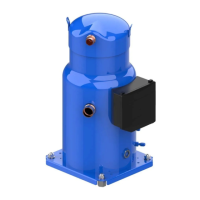
